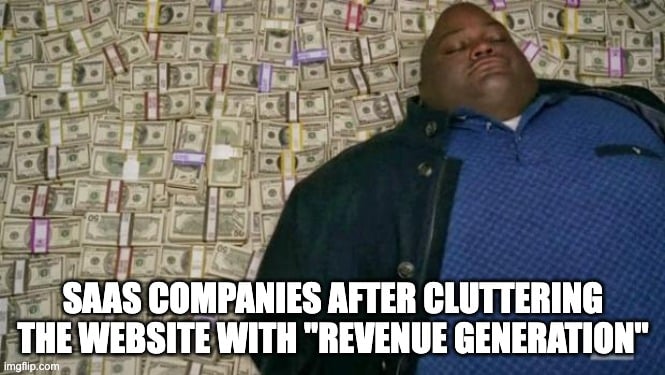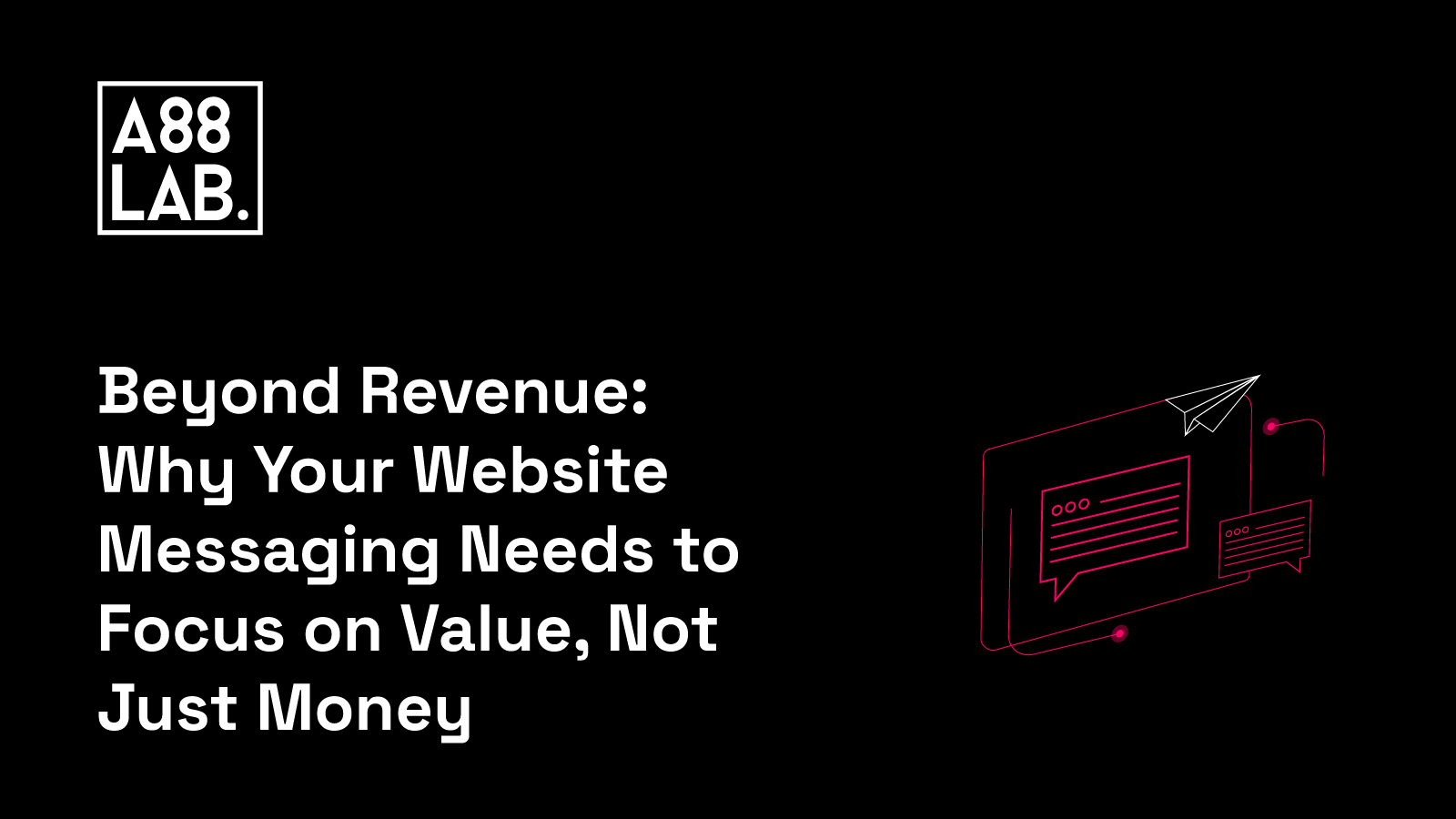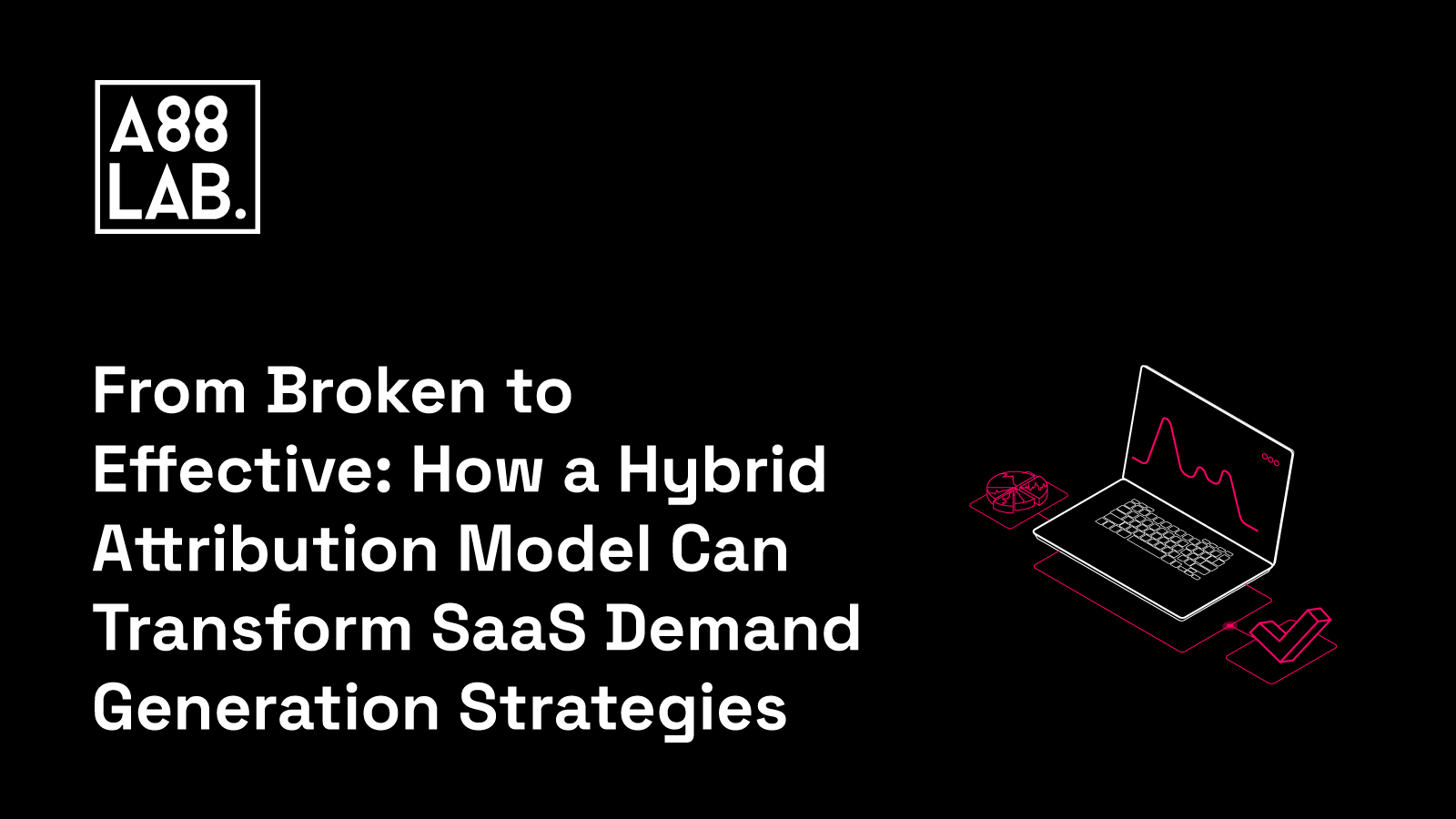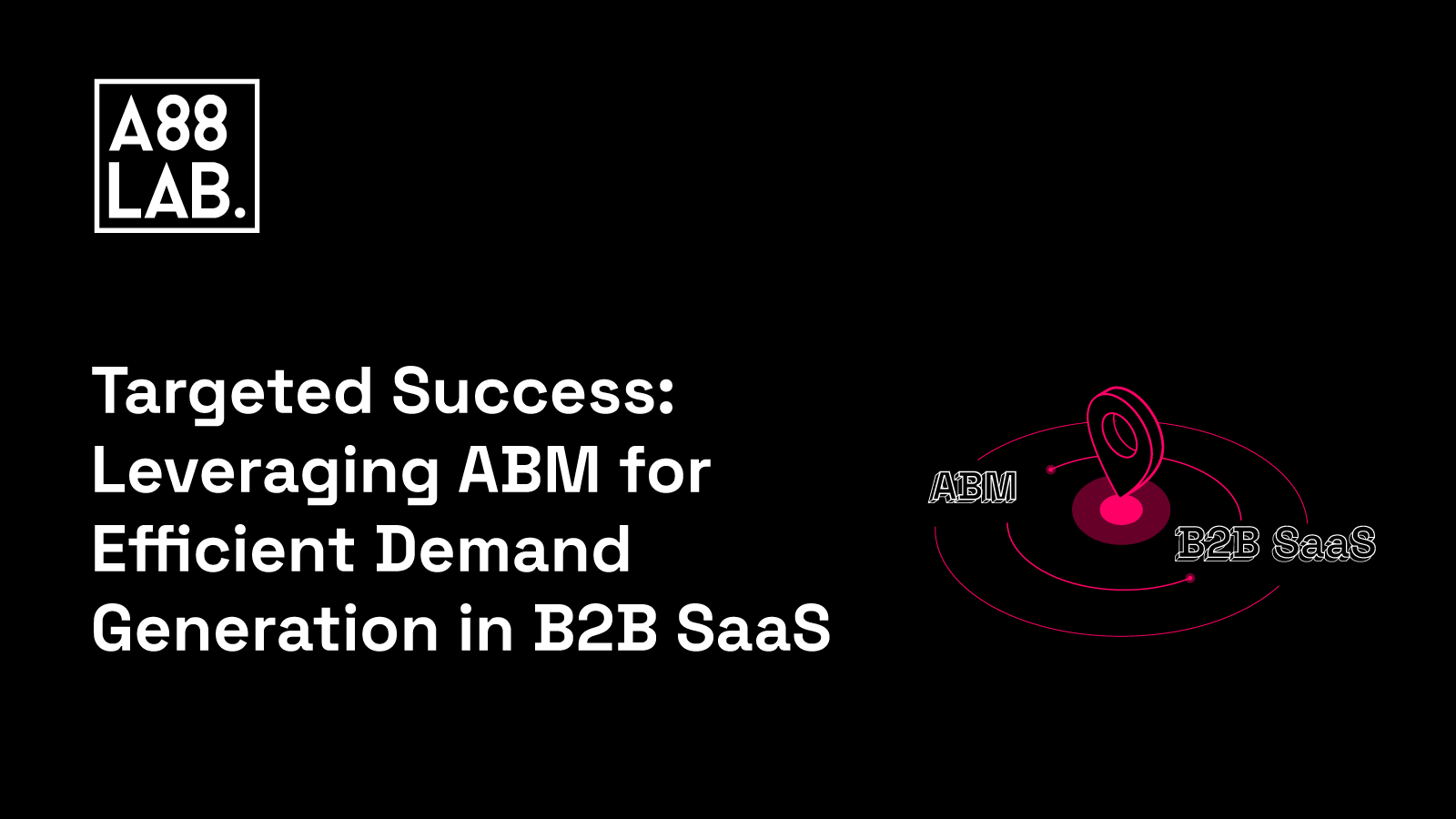Today's SaaS industry is all about the bottom line. In the highly competitive B2B world, where your success hinges on your ability to effectively communicate your value proposition to potential customers, most companies focus on one thing only: revenue!
While driving revenue is undoubtedly a crucial goal for any business, relying solely on revenue-focused messaging can have unintended consequences.
In recent years, there has been a prevailing trend of companies placing a heavy emphasis on revenue generation as their product's primary selling point. And at the time, we all jumped on the same bandwagon.
This approach stems from a perfectly understandable reason—CFOs and financial decision-makers are increasingly tightening their company's belts, especially during economic downturns. As a result, there is a widespread push to demonstrate how your platform or solution can directly contribute to revenue growth.

On the surface, this revenue-centric messaging might seem like a winning strategy and the only logical path to follow. After all, showing how your product can drive revenue is an attractive USP, particularly when businesses seek ways to boost their bottom line. However, effective messaging goes beyond solely highlighting revenue-driven selling points.
In this blog post, we will delve into the reasons why your website messaging should avoid the narrow focus on revenue. We will explore the limitations of revenue-centric messaging, its impact on differentiation, and the potential alienation of your target audience. Finally, we will guide you on unleashing your unique value proposition and crafting a compelling message that resonates with your customers.
The Crowded Landscape: Why Revenue-Focused Messaging Falls Short
If you're in the B2B SaaS or Tech industry (and we assume you are), you know the competition is fierce. Even within specific industries or niches, there are always at least several platforms and solutions vying for market share. And, as the number of competitors grows, it becomes increasingly difficult to differentiate your product from the competition.
In an effort to stand out from the crowd, many companies have adopted a revenue-centric messaging strategy, highlighting their product's revenue-generating capabilities. After all, what executive or financial decision-maker would turn down the chance to save money while increasing their ROI?
As a result, every SaaS website you click on essentially screams the same thing:
"Our product will save you time and/or money, increase revenue, and generate more ROI!".
And they all say pretty much the same thing:
- #1 platform
- "revolutionary" solution
- capability to be 10x better than anyone else, etc.
In a landscape where everyone is touting the same message, differentiation becomes virtually impossible.
While there is nothing inherently wrong with emphasizing your product's revenue-generating capabilities, it is important to remember that relying solely on this strategy only goes so far.
Here are some of the key reasons why:
Saturation of Revenue-Driven Claims
As discussed earlier, revenue-driven messaging is everywhere in the B2B SaaS industry. Potential customers are bombarded with messages promising cost-savings and revenue growth, making it difficult for your brand to cut through the noise and capture their attention.
Lack of Differentiation
When every company focuses on revenue as the primary selling point, it flattens the perceived differences between products. Your product's actual selling points and differentiation get overshadowed, leading to a homogenized market perception.
Misalignment With Target Audience and Demand Generation Efforts
While revenue generation might be a priority for CFOs and financial decision-makers, it's essential to consider the broader audience visiting your website and using your product. Yes, they may be the ones signing off on the purchase, but none of them will swipe a credit card without ensuring your solution benefits the final users. By exclusively focusing on revenue generation, you risk alienating your target audience that is looking for a solution tailored to their specific needs.
Narrow Focus on Monetary Metrics
Revenue is just one aspect of the value your product brings to customers. By solely emphasizing revenue, you overlook other key metrics that matter to your users, such as efficiency, productivity, scalability, customer satisfaction, and overall business growth. Your messaging should reflect your product's holistic value proposition and its broader impact on your customers' success.
Competition Across Unrelated Product Categories
When every company emphasizes revenue as the main value proposition, it creates the risk of commoditization across unrelated product categories.
For example, CRM and HR software are very different solutions with distinct needs, but if both companies emphasize revenue-generating capabilities in their messaging, some potential customers won't be able to perceive the differences between them.
Overshadowing Unique Selling Points
As revenue-driven claims become ubiquitous, chances are your product's unique features and advantages will get lost in the shuffle. What sets you apart from the competition? What is your competitive edge? What unique features, capabilities, and benefits are you offering? Revenue should not be the only answer.
Evolving Customer Buying Journey
The buying journey has evolved significantly in recent years, with customers conducting extensive research and seeking information online before making a purchase decision or even booking a demo. During this research phase, customers seek answers to various questions, such as: "How will this product help me achieve my goals?" and not just how much money it will save them. Revenue-focused messaging may not resonate with customers exploring options and evaluating factors beyond immediate revenue impact.
Emotional and Aspirational Appeal
At the end of the day, people don't buy products and solutions based on logical arguments alone. More often than not, purchasing decisions are based on emotions, aspirations, and the overall value they perceive in a product. Revenue-centric messaging often fails to tap into these emotional drivers and the aspirational aspects that motivate customers.
Unleashing Your Unique Value: Going Beyond Revenue Generation
If everyone else is talking about the same goals and benefits, how can your SaaS business stand out from the competition? Simply go beyond the narrow focus of revenue generation and instead showcase what you really bring to the table. Here are some simple ways to start:
Key Differentiators
Ask yourself, what truly sets you apart from the competition? What made you want to create this product in the first place, instead of relying on existing solutions? Where did you see that initial market hole that your product could fill? Is it a unique feature, capability, or benefit? Is there a particular problem your product can solve better than anything else on the market? Write down these key differentiators and move on to the next step.
Tangible and Intangible Value
Once you have identified your key differentiators, start thinking of ways to convey the tangible and intangible value they bring to customers. Tangible value includes metrics such as cost savings, time efficiency, increased productivity, or improved performance. Intangible value encompasses aspects like brand reputation, thought leadership, trust, and peace of mind. Take notes on how your product delivers both value types and how you can incorporate them into your messaging.
Real-World Success Stories
Nothing speaks to potential customers better than success stories from existing customers. Dig deep into your customer base and find interesting stories demonstrating your product's real-world value. Identify the challenges customers faced before engaging with you and highlight specific results, such as increased customer acquisition, reduced churn, streamlined operations, or improved customer satisfaction. Authentic success stories will always give you the guidance you need to craft effective value-driven messaging.
Industry-Specific Solutions
Think about how you can tailor your messaging to meet specific needs or address the unique pain points and requirements of different industries or verticals. What solutions do you offer that are tailored to a particular industry? How can customers in those industries leverage your product to achieve their goals? Be as perceptive and detailed as possible, and note down the unique value your product can provide customers in different industries.
Customer-Centric Benefits
Finally, think about the benefits and outcomes beyond the revenue that your customers expect to gain from using your product. Demand generation is all about establishing quality relationships by helping and educating your target audience. How will it affect their daily workflow? What areas of their business will see the most improvement? How will it simply their processes? List all the customer-centric benefits your product brings and connect the dots between your product's features and the positive impact they have on your customers' lives or businesses.
Once you nail down the customer-centric value of your product, you can start fine-tuning your messaging and marketing content around it. Only now we can introduce money and revenue back into the messaging — as a result of the value, not as the main driving force.
To learn more about how content production connects to your demand generation efforts, check out our blog post "Ditch the Gate: How to Build Trust and Demand with Ungated Content".
Balancing the Narrative: Integrating Revenue Into the Value Story
No matter how lazy or uncreative it may look on the website, revenue generation is still a fundamental goal of any SaaS business. So, when crafting your messaging and website content, how do you integrate the return on financial investments into the bigger story, without saying the same thing a million other businesses are saying?
The trick is to balance the narrative between value and revenue and focus on outcomes, not just money. Revenue should be seen as a result of the value — something that comes along when you invest in a valuable product. Instead of leading with it as the sole selling point, position it as one piece of the larger value puzzle.
Start by capturing your audience's attention with the broader value and benefits your product provides. Then, seamlessly integrate revenue-related messaging to reinforce the financial impact your product can have. Make sure it's integrated as part of the overall value proposition, showcasing how it complements and enhances the broader impact of your product.
Use the language that resonates with your target audience, and frame your messaging in terms of the outcomes they desire and the problems you solve. Show them the financial justification that decision-makers seek is a result of an effective solution — not just a goal.
Final Thoughts
If you're crafting content and messaging for your SaaS business, or have a final word on what will be included on your website, don't forget to ask yourself: What is at an absolute premium for my target market or niche? What will my customers value the most? Now, if the answer is still money above all else, consider how to break away from the traditional revenue-driven messaging and distinguish yourself in a sea of competitors.
Even with ROI as a primary goal, your homepage shouldn't scream dollar signs. That simply means you have a good idea of what drives decisions in your market, which is a great place to start. Now that you know the "what," focus on the “why” and the "how." But please, stir away from the heavily generic and cliché messaging. We can all do much better than that.
.png)


